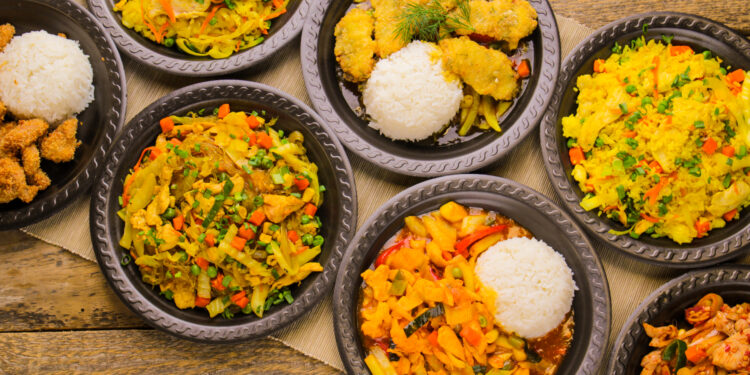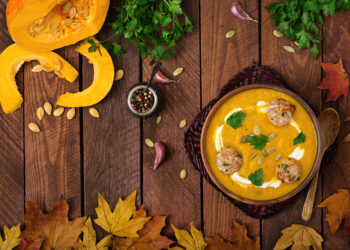Fusion dishes like curry crab & dumplings, pepper roti, dal puri wraps, aloo pie, and mango achaar are more than just flavour-packed favourites, they’re edible testaments to the Indo-Caribbean experience. In this article, we explore the origins of these iconic creations, their cultural significance, and where you can find them across the UK.
Fusion Dishes: They sound like something from a trendy London bistro with a tasting menu and exposed brick. But for Indo-Caribbean communities, fusion isn’t a fad, it’s a flavour-packed legacy. Born from migration, resilience, and a whole lot of spice, Indo-Caribbean cuisine marries Indian heritage with Caribbean rhythm in dishes that are bold, soulful, and deeply personal.
Flavours that travelled: 5 Indo-Caribbean Fusion Dishes You Need to Try
Today, we’re serving up five fusion dishes you didn’t know were Indo-Caribbean. These aren’t just culinary curveballs; they’re edible stories of how East met West, via sugar plantations, steel pans, and second helpings. So, Let’s dig in.
1. Curry Crab & Dumplings — Tobago’s Unexpected Masala Match
You wouldn’t expect to find rich, turmeric-laced curry slathered over crab legs on a sun-drenched beach in Tobago — and yet, that’s exactly where this iconic dish thrives.
Origin: The roots of curry crab & dumplings lie in Tobago’s bustling fishing villages, where fresh blue crab meets Indian-inspired curry blends. Add chewy boiled dumplings (think giant spinners or soft discs), and you’ve got a dish that’s as messy as it is magical.
The Indo-Caribbean twist? The curry base. Tamarind, cumin (Jeera), garlic, and Scotch bonnet are stewed low and slow, making the sauce cling to every claw. The dumplings are pure Caribbean comfort, often made with flour and water, sometimes with a hint of coconut milk if you’re lucky.
Fun fact: In Tobago, eating curry crab is a full-body workout. If you’re not sweating from the Scotch bonnet, you’re battling claws for the meat. Worth every bite.
2. Pepper Roti — A Flaky Flatbread with Serious Fire
Don’t be fooled by the name: this isn’t your average cheese toastie. Pepper roti is what happens when paratha gets a spicy Caribbean makeover.
Origin: Created in Trinidad, pepper roti reflects the influence of Indian flatbreads with a serious dose of island heat. Think flaky buss-up-shut style roti, stuffed with a fiery filling of grated carrots, cheese, Scotch bonnet, and spices.
It’s a dish that perfectly embodies the Indo-Caribbean kitchen’s attitude: take something familiar (roti), add local veg and volcanic peppers, and transform it into something brand new.
Make your own: grab some store-bought paratha, stuff it with spicy cheese and veg mix, and toast on a tawa. It won’t be exactly like your auntie’s, but close enough to fool yourself.
Serving tip: Best eaten hot with mango chutney or a side of shadow beni (culantro) sauce for the full Trini effect.
3. Dal Puri Wraps — The Original Curry Burrito
If roti is the canvas, dal puri is the masterpiece. And when it’s rolled up around curry, it becomes the Caribbean’s answer to the burrito, long before food trucks got the memo.
Origin: Dal puri came to the Caribbean with Indian indentured labourers in the 19th century. Originally, a North Indian dish, the Caribbean version evolved into thin, savoury flatbreads filled with seasoned ground split peas, cumin, and garlic.
When wrapped around stewed chicken, goat curry, channa and aloo, or pumpkin, it becomes a meal-on-the-go that rivals any fast food, with more soul and spice.
Where to try it in the UK:
- Rhythm Kitchen (Stratford, London) both offer dal puri wraps with various fillings.
- Or get frozen dhal puri from your local Asian/Caribbean grocer, heat, stuff, and roll.
Word of warning: Eating a dal puri wrap while wearing white is a rookie mistake. That curry will travel.
4. Aloo Pie — The Curry-Filled Cousin of a Cornish Pasty
You’ve had samosas. You’ve had pastries. But have you had an aloo pie? Imagine a golden, fried pastry filled with curried mashed potatoes, herbs, and Scotch bonnet, then drenched in tamarind sauce and topped with cucumber chutney.
Origin: Aloo pie is Trinidad’s most addictive street food, sold from roadside carts and train stations. It blends Indian spiced potato fillings with West Indian pastry sensibilities.
While it looks deceptively simple, it’s a symphony of textures, crispy outside, fluffy inside, tangy topping, and a chilly kick that creeps in at the end.
Where to try it in the UK:
- Island Delight (Birmingham) often have aloo pies on offer.
- DIYers can use pre-made pastry and mashed potatoes spiced with jeera, turmeric, garlic, and Scotch bonnet.
Pair it with: A cold ginger beer or sorrel. Trust us, it tames the heat while keeping the vibe spicy.
5. Mango Achaar — Sweet, Sour, Spicy, and Unapologetically Addictive
No Indo-Caribbean meal is complete without something pickled and mango achaar delivers a punch to all the senses.
Origin: Derived from the Indian “achar” (pickle), mango achaar uses firm, green mangoes mixed with roasted spices like fenugreek, mustard seed, garlic, and chilli powder. It’s then doused in hot oil to lock in the flavour and left to ferment slightly, creating a spicy, tangy condiment that lifts everything it touches.
Achaar is an Indo-Caribbean staple served alongside roti, rice, or even fried fish. It’s not a main dish, but its impact is mighty.
Where to try it in the UK:
- Check your local Caribbean grocery or online markets like Tropical Sun or Sainsbury’s “World Foods” aisle.
- Or make your own with green mangoes, a spice grinder, and a little culinary courage.
Pro tip: Don’t limit it to roti. Try it with grilled cheese, burgers, or even a cheese board for a desi-Caribbean twist.
How Did These Dishes Happen?
Indo-Caribbean food exists because of a long and complex history, starting with the arrival of Indian indentured labourers in Trinidad, Guyana, and Suriname in the 1800s. They brought spices, legumes, and flatbreads, adapting them to local ingredients and climate.
What emerged is a cuisine that’s inventive, vibrant, and unafraid to mix masala with cassava, or bhaji with breadfruit. Over generations, these dishes became cornerstones of family tables, street stalls, and celebration feasts, quietly influencing global palates along the way.
And thanks to the UK’s thriving diaspora, these flavours are now woven into Britain’s multicultural food scene, from homemade tiffins in Leicester to food stalls in Peckham.
Where to Find These Dishes in the UK
- Trinidad Roti Shop, London
- Rhythm Kitchen, Stratford
- Island Delight, Birmingham
Final Thoughts: Fusion, But Make It Real
“Fusion” may be a buzzword in food circles, but for Indo-Caribbean cuisine, it’s simply reality. It’s what happens when you bring together spices from Gujarat, produce from the Caribbean, and a whole lot of love passed down in handwritten recipes and oral traditions.
These five dishes, curry crab & dumplings, pepper roti, dhal puri wraps, aloo pie, and mango achaar are just the beginning. They tell a story of resilience, identity, and mouth-watering creativity.
So, next time someone tells you fusion food is overdone, offer them a bite of your pepper roti. Then ask them how many generations it took to perfect that heat.
Got a favourite Indo-Caribbean fusion dish? Share your recipe, memories, or best spice mix hacks in the comments. And if you’ve tried any of the spots mentioned above, let us know what you ordered (and whether you went back for seconds).
Follow currybien.co.uk/ for more delicious deep dives into the flavours of the Indo-Caribbean diaspora and don’t forget to pass the dal puri.




















